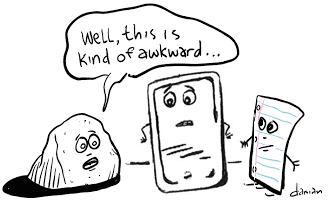 In the grand scheme of things, where does print still rank? According to Aisling McCarthy in Media Update, as a marketing channel print finds itself on good old terra firma again.
In the grand scheme of things, where does print still rank? According to Aisling McCarthy in Media Update, as a marketing channel print finds itself on good old terra firma again.
“Print media is surviving in spite of the predictions of some doomsayers,” McCarthy writes. “In fact, in a number of areas, it remains the preferred format. As the dust from digital’s disruption begins to settle, print may be finding some safe footing once again.
Others agree, including Mark Beare, director of content marketing agency The Publishing Partnership.
“Print has proved to be more resilient than people thought,” Beare said to McCarthy. “I think there was an ‘over-correction’ three or four years ago, where people thought that everything must be digital, that print wasn’t going to survive at all.”
But why? What is it exactly that keeps print top of the heap as a marketing strategy? McCarthy breaks it down to four specific reasons.
1. People like engaging with print materials
“Although digital seems to offer a multitude of benefits, like being immediately adjustable, free to access and interactive, print media is still very much ingrained in consumers’ collective memory,” McCarthy writes. “This means that people continue to be attracted to, and willing to read, print media, regardless of whether we’re talking about magazines and newspapers, flyers or catalogues.”
Our own research backs that up, as does research from around the industry. People like – and respond to – print.
2. Print stimulates more of our senses
Our brains are wired to engage more deeply with print, due to the way our senses are involved in the experience.
“One exclusive quality that print has and the digital media can never match is just how tangible it is,” McCarthy notes. “Consumers are able to browse through a magazine, feel the paper and even distinguish between certain paper densities and compositions.
“For example, one specific advert may be printed on a thicker, more porous paper that is easy to take notice of, compared to the rest of the glossy sheets in the magazine. Also, there’s the smell of ink on paper that adds to the overall experience of reading something printed,” McCarthy adds.
Print also gives you an experience of “place” in your reading, which leads to better attention, comprehension and recall over digital.
“Very often, when you read something from a printed magazine or book you can recall where on the physical page it was when you saw it – you can recall if you were two-thirds of the way through, or half of the way through,” explains Beare.
3. Different print channels have their own benefits
Something that’s often overlooked is that not all print is the same.
“When you think of print media, what do you think of? Newspapers, magazines, leaflets? Each one of these types of content has something to offer and has found its own niche of readers, playing a very specific role in their lives,” McCarthy explains.
Magazines offer that long, slow read that’s so important, especially when looking for credibility and accuracy. Catalogs and direct mail have their own benefits, offering a chance to connect directly with a potential customer.
4. Print can truly captivate readers
Compared to the way we mindlessly scroll through our mobile feeds, print offers a truer form of engagement with our audience.
“Once they start reading, there are no other bits of news, auto-playing videos or pop-ups taking the spotlight off the article,” McCarthy explains. “This means that a reader’s full attention is oriented to that specific content, which guarantees a greater engagement with the brand since the reader is more likely to be impacted by it and remember it long-term.”
None of this is shockingly new to us (and probably to you), but it’s always good to remind ourselves of the true value proposition of print in the marketing strategy. There’s a reason why print is bringing great returns for the brands that utilize it strategically. It works – on many levels.
